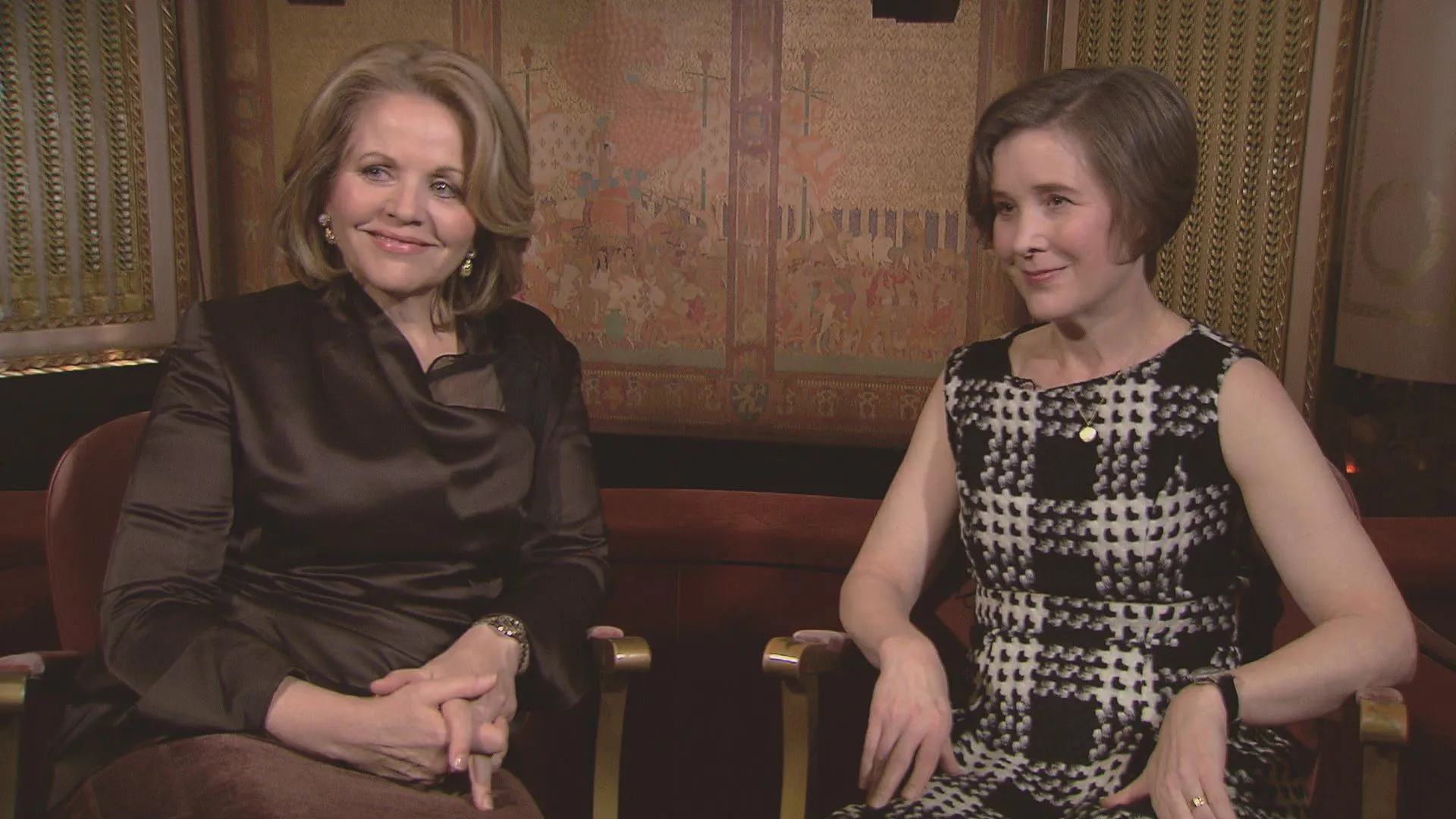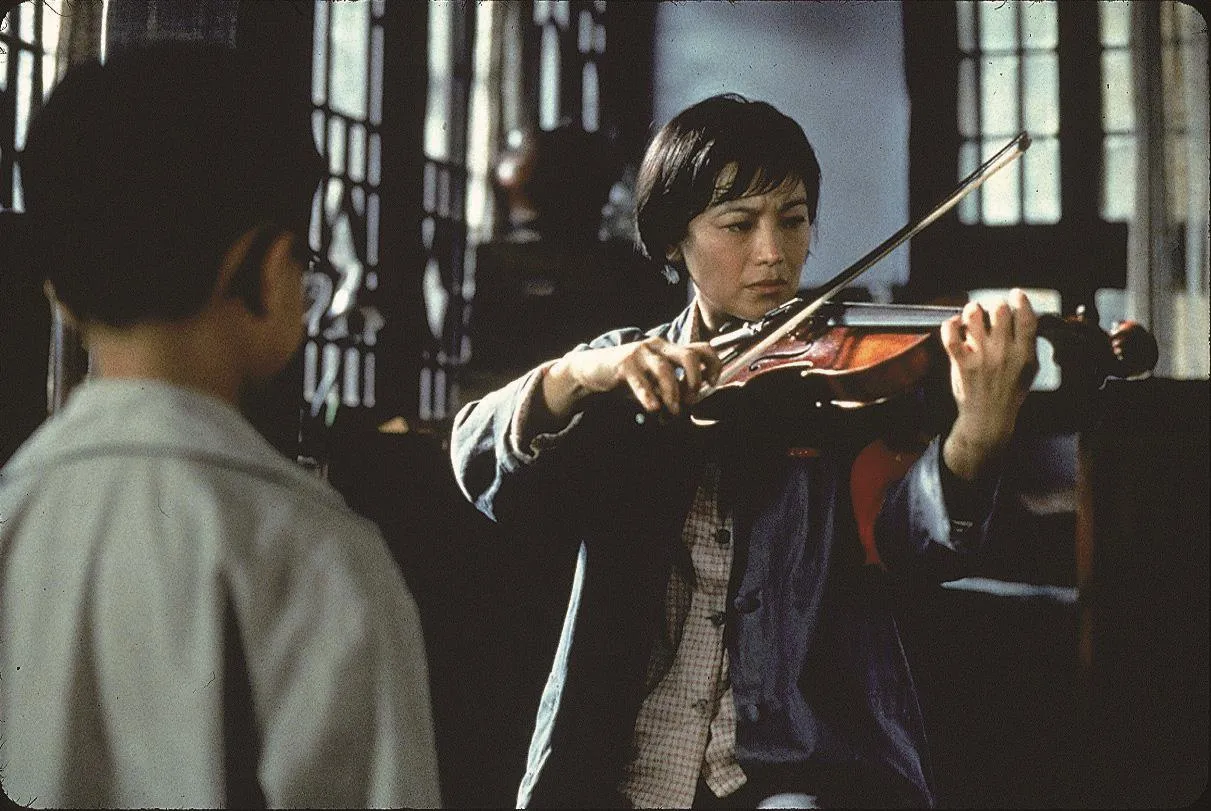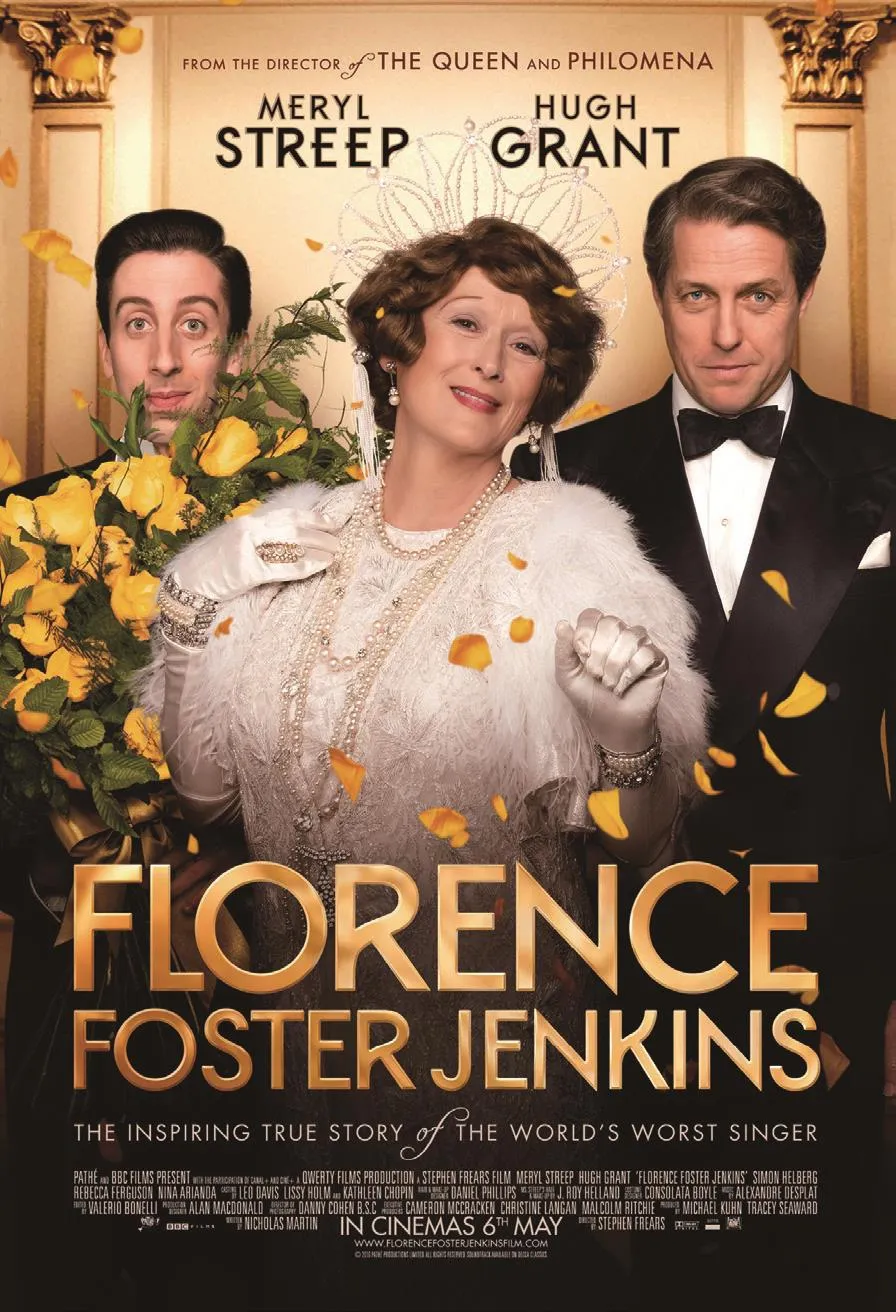歌剧电影中双簧表演的大问题
文:司马勤(Ken Smith) 编译:李正欣

我曾经对英国如此着迷的一件事是:无论是亨德尔歌剧或是好莱坞影片,都是在其他地方流行多时之后,才飘过英伦海峡,又一次掀起热潮。数月前,我翻看伦敦各大报纸,发现周末特刊评论的影片,早在美国或亚洲放映过了,有几部甚至在飞机上的娱乐系统里都已翻滚多时。
真正引起我注意的是《美声》(Bel Canto
,2018,美国)这部电影。导演保罗·威茨(Paul Weitz)请来了朱丽安·摩尔(Julianne Moore)扮演歌剧巨星,故事的主线是恐怖分子挟持人质的暴力事件。歌剧大明星飘洋过海来到拉丁美洲,为一位日本商人的私人盛会担任演出嘉宾。宴会开始不久,一群武装恐怖分子攻进豪华大宅,俘虏了全部宾客。事实上,我在飞机上已经看过这部影片,觉得导演拍得不太好,但也没有上心。后来阅读英国媒体对其的苛刻评论,在读到其中的贬义词时,心里还是感觉有点出乎意料。
朱丽安·摩尔扮演电影《美声》中的歌剧巨星

为电影《美声》幕后献声的音蕾内·弗莱明(右)与原著作者安·帕切特
《卫报》批评它为“挟持人质的空洞故事”;《每日邮报》警告读者,这部电影“在各个层面都令人失望”;《每日镜报》则认为“到了枪战场面出现时,大家都舒了一口气”。某位影评人揶揄《美声》是“真实地营造出被挟持的滋味”,另一位更添油加醋地说:“唯一被挟持的人质就是我,真想逃出电影院。”
首先,我必须强调,自己并没有付钱买票去看《美声》,我也不认为航空公司会为这部糟糕的影片退票——看罢电影,我没有任何冲动,要跑到书店购买安·帕切特(Ann Patchett)的原创小说。尽管如此,这部电影算不上我近期看过最糟糕的——也不是那一周内我看过最差劲的作品。如果说它最差劲,未免是种抬举了。无论最好或最差,在某种程度上都可算是一种荣耀。
但是,某些关于这部电影的评语却令我念念不忘。“一桶桶的煽情肥膏,政治触觉幼稚至极,对嘴型的效果也确实吓人”——这是《泰晤士报》的开场白。另一位影评家叹息地说,“摩尔本是个出色的演员,但她的默剧技巧却不尽如人意。”《标准晚报》甚至建议:既然摩尔饰演歌剧演员的角色可信度不高,为什么不直接让女高音蕾内·弗莱明来演呢?(电影中摩尔角色的歌唱段落,的确由弗莱明录制的。)
我可以肯定,说这话的影评人肯定从来没有看过弗莱明演戏。我在百老汇的舞台上看过她的演出。纵使她扮演的就是一位歌剧明星,你还是得怀着“姑且信以为真”(suspension of disbelief)的心态度过整个晚上。但这确实指出了我对《美声》的质疑。这部电影里对歌者角色塑造的可信度,无论是演员还是导演或者后期制作团队都完全无从下手——他们彻底地失败。

上:《红色小提琴》中,相比起教儿童演员拉小提琴,教一位10岁的小提琴学生表演更为容易

下:张艾嘉在《红色小提琴》中饰演了一位小提琴高手的女儿

右:为《红色小提琴》录制小提琴配乐的乔舒亚·贝尔
***
不久以后,我在亚洲协会香港中心举办的公开讲座中,与因给电影《红色小提琴》(The Red Violin
)配乐而赢得奥斯卡金像奖的作曲家约翰·科里利亚诺(John Corigliano)进行了访谈。电影在1999年上映时,我曾为《洛杉矶时报》写过一篇报道,深入探讨了导演佛朗索瓦·吉拉德(François Girard)为了营造多位演员演奏小提琴时的真实感所投入的资源与精力。此前的几年,也有另一部与音乐有关的电影,那就是《闪亮的风采》(Shine
)。导演斯科特·希克斯(Scott Hicks)安排演员杰弗里·拉什(Geoffrey Rush)模仿患有神经紧张症的大卫·赫夫考(David Helfgott)的钢琴技巧。训练的过程十分艰巨:拉什坐在一台雅马哈自动演奏钢琴(Yamaha Disklavier)前,仔细地跟着电动操作的琴键练习指法。相比之下,到现在为止还没有人成功发明“自动演奏小提琴”——尤其是《红色小提琴》的故事情节中出现了不同年龄层的小提琴手,吉哈德只能采用一些“低科技”的方法来呈现真实的演奏感。导演找来了一位10岁的琴童来饰演影片中的“神童”一角,下功夫教他如何表演(相比起教儿童演员拉小提琴,这要容易得多)。电影中还有一个老年小提琴家的角色。导演请来了一位蒙特利尔交响乐团的退休乐手——请留意,这不是理所当然的——让他来扮演职业乐手,令人信服。乔舒亚·贝尔(Joshua Bell)面对的挑战更大。这位小提琴大师为《红色小提琴》电影中全部的独奏乐段录制配乐,包括华人演员张艾嘉的一小段音乐。张艾嘉扮演了一位小提琴高手的女儿——她学过拉琴,但并不算专业。为了准备拍摄《红色小提琴》,张艾嘉花了几个月时间来学习小提琴基本功。在这一段落里,贝尔需要露出真挚的感情,但只能用上有限的技巧来显示这是一位新手的演奏。对于这么高水平的演奏家来说,要克制自己的技艺更具挑战性。
最令导演头疼的角色,也是整部电影最具挑战性的部分,是一个虚构的角色——19世纪英国小提琴家,名叫弗雷德里克·波普(Frederick Pope)。他是浪漫过度的拜伦与放荡不羁的帕格尼尼的综合体。饰演波普的杰森·弗莱明(Jason Flemyng)模仿拜伦得心应手,却无法胜任帕格尼尼的特质。
在悠久的电影历史中,还有一部1946年由让·尼古拉斯科(Jean Negulesco)执导的《诙谐曲》(Humoresque
)。当中的小提琴演奏片段用了以下的拍摄方法:当时22岁的小提琴大师艾萨克·斯特恩(Isaac Stern)的手指在指板上舞动,但捧着小提琴是演员约翰·加菲尔德(John Garfield)。《红色小提琴》的拍摄过程中,也有令科里利亚诺记忆犹新的小插曲。导演曾把一场戏称为“八爪鱼”的拍摄:在镜头之外,杰森·弗莱明用肩托把小提琴举起来,双手向外伸展;乔舒亚·贝尔站在左边,左手手臂从腋下穿过弗莱明的身体(贝尔的手指在指板上);另一位英国小提琴手站在弗莱明的右边,右手手臂同样穿过弗莱明,将琴弓轻放在琴弦上。左右两位小提琴家的手肘都跟演员的手肘绑在一起。他们一动,演员的身体也会有所反应。***

《爵士风情》中,丹泽尔·华盛顿出演小号手

演员们虽然在模仿指法方面下了功夫,可惜忽略了呼吸节奏,面部肌肉也丝毫不动
这听起来够复杂了吧?但拍摄歌唱家更为艰难,如同攀登珠穆朗玛峰一样。在史派克·李(Spike Lee )执导的《爵士风情》(Mo’ Better Blues
)中,丹泽尔·华盛顿(Denzel Washington)出演小号手。我以前学过小号,一眼就能发现虽然丹泽尔·华盛顿对模仿指法方面下了功夫,看起来有模有样,可惜他忽略了呼吸节奏,面部肌肉也丝毫不动,效果太失真了。歌唱家不存在演奏乐器的问题,但不知何故,拍摄上遇到的问题更加复杂。就算是最成功的音乐剧电影都会困难重重,更何况歌剧电影呢?最近,我翻开多明戈的回忆录(《我的头四十年》),他描述了当年为弗朗哥·泽菲雷利(Franco Zeffirelli)拍摄《茶花女》的场景。这部电影至今仍是歌剧电影最成功的例子。平常拍摄电影,前期的影像部分弄好了以后才加上音乐。但是,拍摄歌剧电影必须先把音乐录制剪辑好,然后拍摄的时候,歌手只能跟播放的录音来对嘴型。
“我觉得有困难。如果我真的跟着录音唱出来——真的发声唱出来——我就听不到自己的录音,因此无法对上嘴型。”多明戈这样写道,“另一方面,如果我为了听到录音而不打开喉咙歌唱,视觉效果就没有可信性:能听到高亢的歌声却看不出歌唱家的嘴唇或喉咙用力的迹象,真是荒谬。”
这让我开始思考。歌剧电影属于特别门类。多明戈的回忆录虽然描绘了以上的情况,歌剧演员在银幕上只是“演歌剧”,跟现实生活中的人物是有界限的。我们坐在观众席,听着普契尼美妙绝伦的旋律;但在《波希米亚人》的世界里,鲁道夫只是在家门前与女生搭讪。
但是,关于歌剧演员的电影又怎样?条件与因素不可同日而语。我的脑海里浮现多年前以及近年来我喜欢的电影。无论是《歌剧红伶》(Diva
)中名副其实的歌剧演员威尔赫梅尼娅·费尔南德斯(Wilhelmenia Fernandez),或是《邂逅维纳斯》(Meeting Venus
)中由格伦·克洛斯(Glenn Close)扮演的歌剧明星,还有,上天保佑我,梅丽尔·斯特里普(Meryl Streep)在《跑调天后》(Florence Foster Jenkins
)的开口发声——那绝对不能算是歌唱!——任何人饰演歌剧演员,必须有充分准备,上场的时候真的要“做秀”。One of the things I used to find so charming about England was that, from Handel operas to Hollywood films, things usually got there only after they became popular somewhere else. Several months ago, I was reading through the London newspapers amused to see that every movie being reviewed that weekend had already been released in the US and Asia. A couple of them had even been showing on the plane.
What really caught my eye wasBel Canto
, a hostage drama by Paul Weitz with Julianne Moore playing an opera singer who travels to Latin America to perform at a birthday party for a Japanese businessman just as the entire party is held captive by a group of guerilla fighters. I’d actually seen it on the plane and didn’t think it was very good, but I wasn’t braced for the critical pile-up.
上:格伦·克洛斯在《邂逅维纳斯》中扮演歌剧明星

下:梅丽尔·斯特里普在《跑调天后》中开口发声

右:出演《歌剧红伶》的名副其实的歌剧演员威尔赫梅尼娅·费尔南德斯

左:电影《美声》海报
“Vacuous hostage drama,” said theGuardian
.“Disappoints on every level,” warned theDaily Mail
.“Bullet fire is a welcome relief,” claimed theDaily Mirror
. “Accurately recreates the feeling of being held against one’s will,” wrote another critic, echoed by a colleague at another paper who wrote, “The only hostage was me wanting to get out of the cinema.”First of all, I admit that I hadn’t really paid to see the film—I don’t think the airline will refund my money, in any case—and it didn’t exactly motivate me to run out and get Ann Patchett’s original novel.But still, I wouldn’t call it the worst movie in recent memory—or even that week. That would be giving it too much credit. There’s still a certain honor in being number one.
A couple of remarks stuck with me, though.“Buckets of schmaltz, political naivety and some truly horrendous lip-synching,” opened the review in theTimes
. “For such a great actress,” another critic wrote, “Moore’s a terrible mime.” TheEvening Standard
even suggested that, since Moore was hardly credible in the role, why not just cast soprano Renée Fleming (who dubbed Moore’s singing voice in the film).First of all, I’m positive the critic hadn’t actually seen Fleming act. I’ve seen her on Broadway,and even playing an opera singer she struggled with credibility. But this did point out one of my major problems withBel Canto
. When it came to representing a singer on film, neither the actress,nor the director nor the post-production crew had a clue about what they were doing.***
Not long afterward, I found myself hosting a screening ofThe Red Violin
at the Asia Society Hong Kong Center with John Corigliano, the film’s Oscarwinning composer. Back when the film came out in 1999 I’d written a piece for theLos Angeles Times
about the lengths to which director François Girard had gone to make the film’s various characters look as if they were actually playing a violin.A couple of years before inShine
, director Scott Hicks had the actor Geoffrey Rush mimic the mentally disturbed pianist David Helfgott by sitting at a Yamaha Disklavier—a digital player piano—and painstakingly following the fingerings that the instrument reproduced. But since there’s no such thing has a “player violin”—and sinceThe Red Violin
had a broad range of characters—Girard had to pursue a number of low-tech strategies.To play a child prodigy, Girard found a 10-yearold violin student and taught him to act (easier, he realized, than trying to teach a child actor to play the violin). For a more mature virtuoso, he cast a retired violinist from the Montreal Symphony who—and this cannot be taken for granted—was able toact
like a professional musician. A greater challenge for violinist Joshua Bell, who recorded all the violin playing in the film, was dubbing for Chinese actress Sylvia Chang. Her character was the daughter of a virtuoso—not a virtuoso herself—and the actress had only a few months to learn rudimentary violin technique. Bell had to play with genuine feeling using only limited performing skills. The hardest thing for a virtuoso to do is reign in his technique.
右页:电影《红色小提琴》海报

上:电影《邂逅维纳斯》海报

下:电影《歌剧红伶》DVD封套
The most problematic character for the director—and the film as a whole—was the fictional 19century English violinist Frederick Pope, a creature of Byronic excess and Paganini-like abandon. Jason Flemyng, the actor in the role, could only manage the first part.
Long gone were the days ofHumoresque
, Jean Negulesco’s 1946 film where a 22-year-old Isaac Stern could simply reach around actor John Garfield to finger the violin in Garfield’s hands. InThe Red Violin
, Corigliano fondly remembered a scene that Girard christened “the Octopus”: just beyond range of the camera, Flemyng had the violin tucked under his chin with his arms extended; Bell, standing to left, had one arm crossing Flemyng’s (hands on the fingerboard) while a British violinist to Flemyng’s right reached across from the other direction to bow the strings. Both violinists had their arms tied to Flemyng’s at the elbow, so that when either moved,the actor’s body followed.***
As complicated as this sounds, it’s all child’s play compared to playing a singer on camera. As a former trumpet player, I remember watching Denzel Washington play a jazz musician in Spike Lee’sMo’
Better Blues
wondering why he took so much care to get the fingerings right but not to breath or flex his facial muscles like an actual trumpeter.Singers don’t even have an instrument between themselves and the camera, but somehow that makes it all even more problematic. Even the best musicals often have trouble getting it right, let alone cinematic operas. Recently I came across Plácido Domingo’s memoirMy First Forty Years
, where he recalls starring in Franco Zeffirelli’s film ofLa Traviata
, still the best example of the genre. Unlike standard filmmaking, where the music is inserted after the visuals are shot, opera films record and edit the musical performance first. Then singers mouth the words to the playback when the camera is rolling.“I find this difficult, because if I really try to sing along with myself—really singing out—I cannot hear myself, and I end up out of synchronization with the recorded sound,” Domingo writes. “On the other hand, if I barely sing at all, in order to hear the soundtrack better, the visual element loses credibility: it is ridiculous to hear powerful sounds emerging from a voice while not seeing any signs of strain in the singer’s mouth or throat muscles.”
That got me to thinking. Opera films are one thing.Domingo’s comments notwithstanding, singers can get away with a lot on screen simply because it’s the performer singing and not the character. Those of us sitting in the audience may be hearing Puccini’s glorious melodies; within the world ofLa Bohème
Rudolfo is merely chatting up a girl in the doorway.But films about opera singers? This is quite another thing entirely. Thinking about some of my old and recent favorites, whether it’s a real opera singer on screen like Wilhelmenia Fernandez inDiva
or an actor playing one like Glenn Close inMeeting Venus
or, God help us, Meryl Streep doing whatever she was doing inFlorence Foster Jenkins
—it can’t properly be called singing!—any actor playing an opera singer on screen had better be ready to put on a show.
右页:电影《跑调天后》海报

